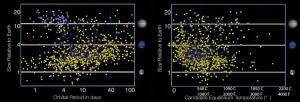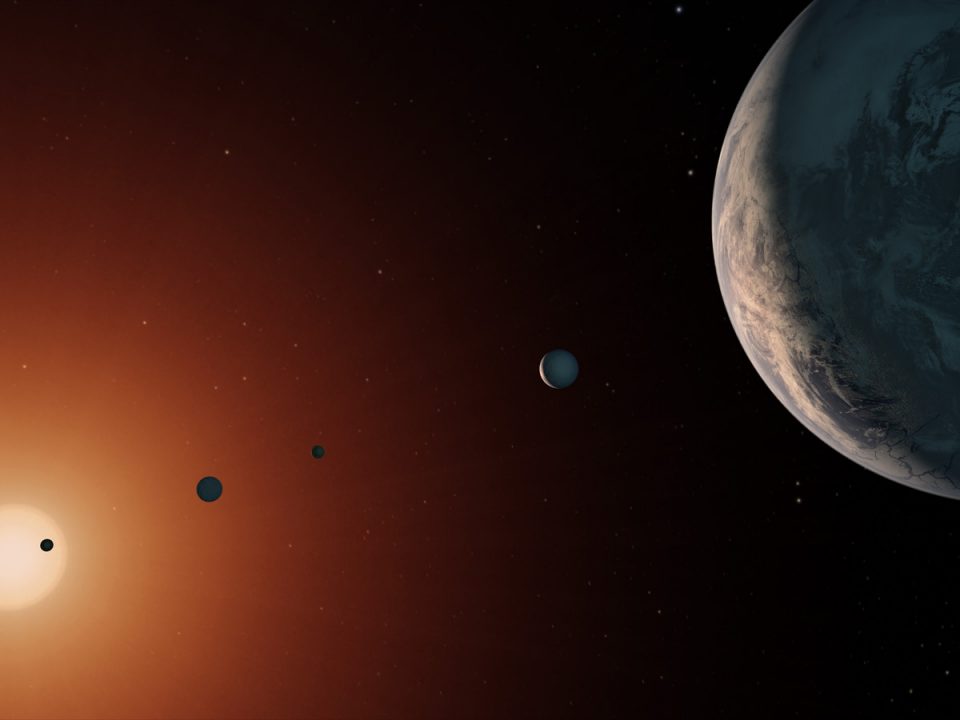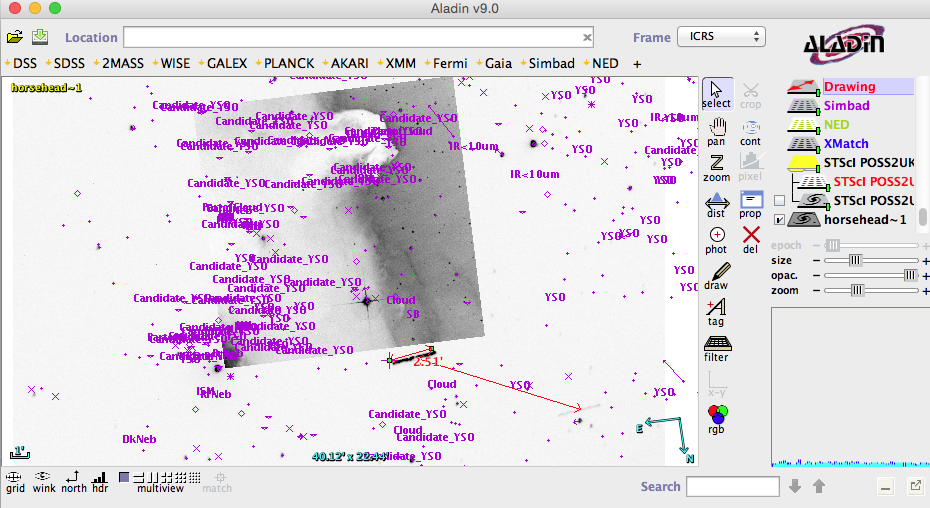A landslide of Kepler Exoplanet Candidates
Kepler-10b – The first unambiguous rocky exoplanet
January 10, 2011Cosmic Diary Blog hosted at the SETI Institute
February 10, 2011There will be a before and after Kepler Era in astronomy. Today, with the release of 1,202 exoplanet candidates from data collected with the Kepler spacecraft over 140 days of observation, we have just entered in a new age of astronomy.
The Kepler spacecraft is the 10th NASA Discovery mission launched in March 2009 which was designed to search for exoplanets by measuring almost continuously the brightness of 156,453 stars in a small 12 degree diameter patch of the sky. The 0.95m-telescope is able to detect attenuation of the host star located in the Cygnus, Lyra, Draco constellations which could be due to the transit of an exoplanet passing between its star and us. A transit gives direct estimate on the size of the exoplanet and its orbit.
The Kepler team released on February 1, 2011 the data from the first 136 days of operation of the spacecraft. An article (Borucki and 64 colleagues, 2011) summarizing the key results from these observations after a detailed data processing and careful analysis are about to be submitted. I am summarizing in this post the key results of this remarkable work.

The FOV of view of Kepler with the location of the exoplanet candidates and their family classification per size (credit: NASA-Kepler team)
The dim attenuation of light of the host start due to the passage of an exoplanet was identified by the Kepler team for 1,202 potential exoplanets. Because for most of them, the radial velocity measurement (due to the wobbling of the star due to the exoplanets) and the close vicinity of the star are not yet known, the genuineness of these exoplanets are not yet fully confirmed. A careful statistical analysis allowed the team to conclude that 80-90% of these candidates are probably real. You may know that the Extrasolar Planets Encyclopedia contains currently 519 exoplanets which were discovered over 15 years of observations. In 4 months of operation, the Kepler mission have tripled the number of known exoplanets. The figure on the left shows the location of these 1,202 exoplanet candidates in the field of view monitored by Kepler telescope.
More than just discoveries, the Kepler data give us the opportunity to study statistically the properties of these exoplanets. For the first time, astronomers are able to define families of exoplanets arbitrary classified per size which are:
– 68 Earth-size exoplanets with a radius (Rp) of less than 1.25 Earth radius (Re)
– 288 super-Earth size exoplanets with 1.25 x Re < Rp ≤ 2.0 x Re
– 662 Neptune-size exoplanets with 2.0 x Re < Rp ≤ 6.0 x Re
– 165 Jupiter-size exoplanets with 6.0 x Re < Rp ≤ 15 x Re
– 19 very-large-size with 15.0 x Re < Rp ≤ 22 x Re
The figure below summarizes the candidate size versus orbital period and candidate equilibrium temperature. The horizontal lines mark the limit between these families of exoplanets.
Several exoplanets orbit around M- and F- type stars which have lower temperature than our Sun. Consequently, the surface temperature of the exoplanets could permit the presence of liquid water. In their paper, the Kepler team lists ~60 candidates with sizes ranging from Earth-size to larger than that of Jupiter which are in the Habitability Zone of their host star. This is obviously one of the most remarkable results of this survey.
There are much more to say about this catalog of exoplanet candidates. For instance, we can now say that stars in our Milky Way galaxy are more likely to host small exoplanets since 75% of the Kepler catalog exoplanets are smaller than Neptune, with a peak of exoplanets only 2-3 times larger than Earth.
Using model predictions which take into account the probability of having the correct geometry to detect these exoplanets, the Kepler team extrapolated that 6% of the stars in our Milky way have Earth- and super-Earth size exoplanets, 17% of them have Neptune-size candidates and only 4% of them have Jupiter-size exoplanets.
However, only 14% of the host stars have multi-candidate systems, including one multi-planet system named Kepler-11 with 6 planets which was also announced today (link here). The lack of more distant exoplanets is the survey is probably an observational bias since Kepler was in operation for only 4 months, so the longest orbital period attainable currently with the Kepler data is ~140 day, corresponding to a distance of 0.5 AU from an host star. Since this is less than the distance between our sun and Venus, Kepler-11 is a surprising system with 6 Neptune-size exoplanets (Rp~2-4 Re) orbiting in a very compact configuration around their Sun-like host star. Multi-planet systems seem to be all astonishly unique and interesting.

Artistic illustration of the multiple planetary system Kepler-11 (credit: Nature / NASA / Ames / JPL-Caltech / T. Pyle)
The Kepler mission is still in operation and new data are collected with a cadence of 30 min, on a time baseline significantly larger than this first catalog. We should expect in a few years to have a more accurate and complete catalog, which might contain smaller exoplanets, exoplanets orbiting at larger distance from their host star and even satellites of these exoplanets. The involvement of a large community of astronomers is now needed to confirm and refine this catalog by collecting additional observations.
Tonight if you look at the sky, you may consider to pause from your hectic life and think that among these 2,500 stars that can be seen with without a telescope, a third of them may host an exoplanet. If it is not enough to appreciate the plurality of other worlds, you should remember that our Milky Way galaxy is composed of ~200 billion of stars. This first version of the Kepler catalog tells us that several hundred million of them could have an exoplanet with a surface temperature adequate to sustain liquid water.
That’s a lot of interesting worlds out there, now we just need to explore them.
Clear Skies
Franck Marchis @AllPlanets



